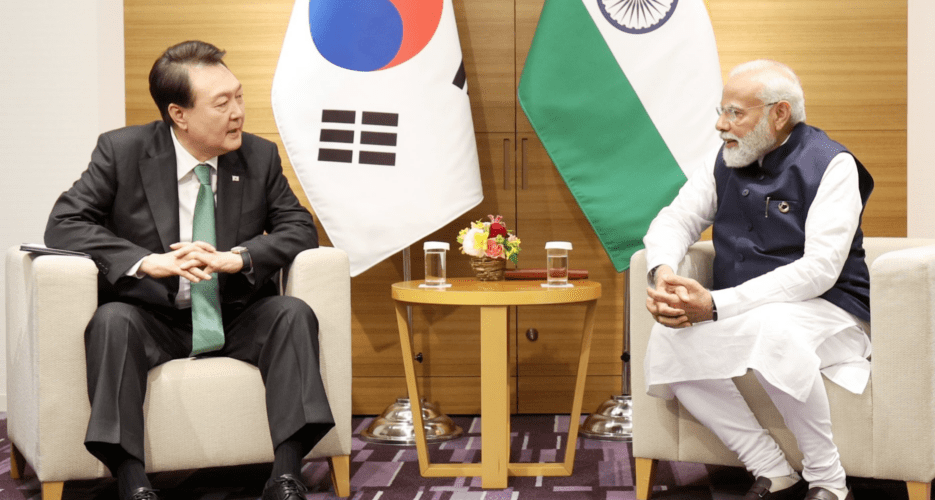|
Analysis Where South Korea and India’s ‘relationship in progress’ stands after 50 yearsCurrent leaders are emphasizing ROK-India ties on paper but must do more to ensure mutual success, experts say Shreyas ReddyAugust 17, 2023  South Koream Yoon Suk-yeol and Indian Prime Minister Narendra Modi hold talks in Hiroshima, May 20, 2023 | Image: PMO India via Twitter South Korea and India look to elevate relations as they celebrate 50 years of full diplomatic relations this year, but experts say they must prioritize each other much more to realize the bilateral partnership’s potential in the years to come. The two countries marked their liberation from colonial powers earlier this week, on Aug. 15, but they have more than a national day in common. Under South Korean President Yoon Suk-yeol and Indian Prime Minister Narendra Modi, the rising Asian economic and cultural powers have sought to take the relationship forward in areas of mutual interest such as trade, science and technology and maritime cooperation. But despite these shared interests, they have long had a “low profile relationship” as they prioritized other regional partners, according to Jagannath Panda, head of the Stockholm Center for South Asian and Indo-Pacific Affairs at the Institute for Security & Development Policy (ISDP). “The priority of South Korea toward India and vice versa has not been very prime, primarily because the areas of interest have not really been prioritized,” he told Korea Pro. But this could soon improve as Seoul looks to emphasize trade with New Delhi, said Kyung-hoon Kim, an associate research fellow at the Korea Institute for International Economic Policy (KIEP). “We’ve been fairly slow in devising policies to strengthen our relationship with India, but Korea is certainly viewing India as a major partner in the Indo-Pacific strategy,” he said.  Samsung established the world’s largest mobile phone factory in India, July 10, 2018 | Image: Indian Ministry of External Affairs via Flickr EVOLUTION OF ROK-INDIA TIES South Korea and India established full diplomatic relations in Dec. 1973, but the seeds of the relationship were sown long before. Politically neutral India played a leading role in U.N. activities in post-division South Korea’s early years, before, during and after the Korean War. Newly independent India actively participated in the U.N. Temporary Commission that oversaw elections in South Korea in 1948. Once the war broke out, it soon entered the fray to provide humanitarian assistance under the U.N. flag. New Delhi again showed its neutral leadership through prisoner repatriation and peacekeeping operations after the war. But India-South Korea ties subsequently ended up on the back burner due to South Korean President Syngman Rhee’s distrust of India’s socialist ideals and shifting foreign policies in both countries. Sticking with its non-aligned approach, India established bilateral consular relations with both Koreas in 1962 and eventually upgraded both relationships to ambassador-level engagement 11 years later. “Since the Korean War period, India has maintained a kind of ‘equi-cordial’ and at the same time ‘equidistant’ relationship” with the two Koreas, ISDP’s Panda said, which allows New Delhi to engage both sides directly but maintain a distance from major power politics involving the Koreas. However, Panda added that India had adopted a “low profile engagement” strategy toward Pyongyang due to its increasing aggression, signaling more positive intent toward ROK relations as the rising economic powers step up trade and security engagement. A STEP FORWARD South Korea and India have largely prioritized relations with major regional actors over the years, particularly the U.S., China and Japan, but the current governments now look to take the bilateral relationship to the next level. “Under the Yoon administration, we do see a kind of urgency in South Korean outreach toward India, trying to have a much more focused security-oriented as well as economic-oriented engagement,” said Panda. Yoon’s Indo-Pacific strategy views India as a significant partner on paper, emphasizing expanding trade and investment through the bilateral Comprehensive Economic Partnership Agreement (CEPA). The two sides have been in talks to upgrade CEPA for several years, but this has dragged on due to India’s concerns about its growing trade deficit with South Korea, according to KIEP’s Kim. There has also been slow progress in defense trade, and Kim cited South Korean concerns over India’s rivalry with Beijing, Seoul’s biggest trade partner, as a factor limiting arms exports. But he added that defense companies from both countries could look for new opportunities as Yoon’s Indo-Pacific strategy reduces South Korea’s dependence on China. Seoul and New Delhi eye science and technology cooperation as a key priority, and Kim stated that leading institutions in the two countries are strengthening research partnerships. But the greatest potential lies in increasing South Korean firms’ manufacturing foreign direct investment in India, particularly in IT hardware and software, he told Korea Pro, adding that India could attract major South Korean manufacturers to invest in its domestic semiconductor industry with visible incentives. As the two Asian cultural powerhouses’ mutual awareness grows thanks to the global success of the Korean Wave and India’s film industry, Panda sees high growth potential for tourism, cultural exchanges and people-to-people interactions. He also points to other emerging areas of cooperation as positive indications, particularly maritime exercises, coastal development and the green economy, and stated these could provide opportunities to demonstrate regional leadership through multilateral initiatives with third-party countries.  An Indian sailor welcomes a ROK navy training ship, Sept. 2022 | Image: Indian Ministry of Defense Directorate of Public Relations CHALLENGES AND OPPORTUNITIES The experts see tremendous potential for South Korea-India cooperation in the coming years but say the focus on other countries remains the biggest hurdle. Panda noted that New Delhi’s engagement with Seoul has lagged behind its relations with Tokyo, one of India’s main regional partners courtesy of the Quad, while South Korea has similarly focused on the ROK-U.S. alliance at the expense of other regional partnerships. He added that for the two countries to boost their relationship and regional influence, they must not get caught up in politics between major powers, namely the U.S., China and Japan. Kim concurs, stating that despite the Indo-Pacific strategy’s push to strengthen ties with India, Seoul’s priority over the past year has been “rejigging our relationship with the major powers.” With the biggest population in the world, India’s potential makes it a particularly attractive investment proposition in the decades to come, and Kim fears Seoul could struggle to compete if it does not act soon. “The biggest challenge currently — whether we are trying to increase investment or strengthen our trade relations, or increase our development assistance — is that India is so hot at the moment,” he said. This anniversary year offers a timely opportunity to announce major projects and build a strong foundation for the next half-century, but he fears Seoul could miss this chance as its attention remains squarely on the U.S. and Japan. “Over the next 50 years, Korea has to work much, much harder to strengthen our bilateral relations with India,” Kim said. He added that failure to tap into India’s growth and manufacturing potential could create significant roadblocks to diversifying Seoul’s global value chain and export market. In the short-to-medium term, Kim sees South Korean development assistance to India as a key factor in strengthening the relationship but adds that in the longer term, the South Korean government and companies must expand investment in India. Over the next 50 years, Panda sees promise for this “relationship in progress” but says without more substantial commitments, the partnership is unlikely to influence regional geopolitics like the India-Japan relationship. “Both countries need to prioritize each other as a preferential political partner,” he emphasized. “Unless they do that, the relationship cannot be taken forward.” Edited by John Lee South Korea and India look to elevate relations as they celebrate 50 years of full diplomatic relations this year, but experts say they must prioritize each other much more to realize the bilateral partnership’s potential in the years to come. The two countries marked their liberation from colonial powers earlier this week, on Aug. 15, but they have more than a national day in common. Get your
|
|
Analysis Where South Korea and India’s ‘relationship in progress’ stands after 50 yearsCurrent leaders are emphasizing ROK-India ties on paper but must do more to ensure mutual success, experts say  South Korea and India look to elevate relations as they celebrate 50 years of full diplomatic relations this year, but experts say they must prioritize each other much more to realize the bilateral partnership’s potential in the years to come. The two countries marked their liberation from colonial powers earlier this week, on Aug. 15, but they have more than a national day in common. © Korea Risk Group. All rights reserved. |











